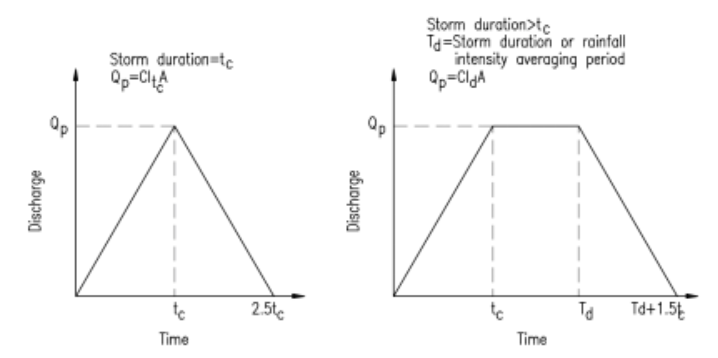The Modified Rational Method is a runoff method common to the USA, used to generate flows in place of a full hyetograph. This method benefits from easy confirmation of results by hand. This method should not be confused with the UK based Modified Rational Method used to generate peak flows during the Network Design.
Due to its static nature, this runoff method does not require dynamic rainfall, and a single or multiple IDF Table can be used. Most design storms can be used as well, as they hold or can generate IDF tables internally. User Defined rainfall or non-IDF deriving rainfall types (e.g. SCS, Long Term or Observed) cannot be used for static analysis.
In order to perform a sizing analysis using the Modified Rational Method, two conditions must be met:
- Each inflow in the phases to be analyzed must be using the Modified Rational runoff method.
- The Analysis Criteria must be set to use Static method, and a suitable rainfall selected.
This method assumes that the rainfall intensity averaging period is equal to the actual storm duration. This means that the rainfall and runoff that occur before and after the rainfall averaging period are not accounted for. Therefore, the Modified Rational Method may underestimate the required storage volume for any given storm event.
Recession Limb Multiplier - The time taken to drop back from the peak to zero after the duration of the event. This defaults to 1 to give a triangular curve, but may be increased to give a longer drain down. A value of 1.5 is commonly used as it better reflects the SCS runoff.
Urban Creep - This scales the impermeable area by the amount specified. This can be used to take the increase of urban areas, or other factors into account. This value is only enabled (and used) when the analysis creep of the Analysis Criteria is set to "Use Catchment Areas ".
Analysis
Calculations are outlined in more detail in the Norfolk, Virginia Engineering Calculations document (pages 5-12 to 5-17).
The method involves the use of the standard rational method equation to generate a peak flow that is then converted into an inflow hydrograph using the following formula:

where:
Q = Flow
Cf = Runoff Coefficient (Adjustment) Factor - Accounts for reduction of infiltration and other losses during high intensity storms
C = Runoff Coefficient
I = Rainfall Intensity – Selected from an IDF table based on the duration
A = Area
The hydrograph is then created using the Recession Limb Multiplier and, additionally, the Duration of Peak, or rainfall averaging period, Td – The duration to run the storm for before the start of the regression (drain down) limb. This must be greater than or equal to the time of concentration. Where equal the curve is a triangular hydrograph.
The graph starts at 0, 0 and then builds up to the peak flow for the Tc value. It will then remain at that flow rate until Td, at which point it will drop back to zero based on the recession multiplier * Tc.
This method will exhibit the exact behavior of the Rational method when the Duration of Peak is equal to the Time of Concentration. Using the Modified Rational method and running it with the Static Runoff Type will return:
- A triangular hydrograph if the Duration of Peak is equal to the Time of Concentration.
- A trapezoidal hydrograph if the Duration of Peak is greater than the Time of Concentration.

Images taken from the Norfolk, Virginia Engineering Calculations, Figure 5-5
